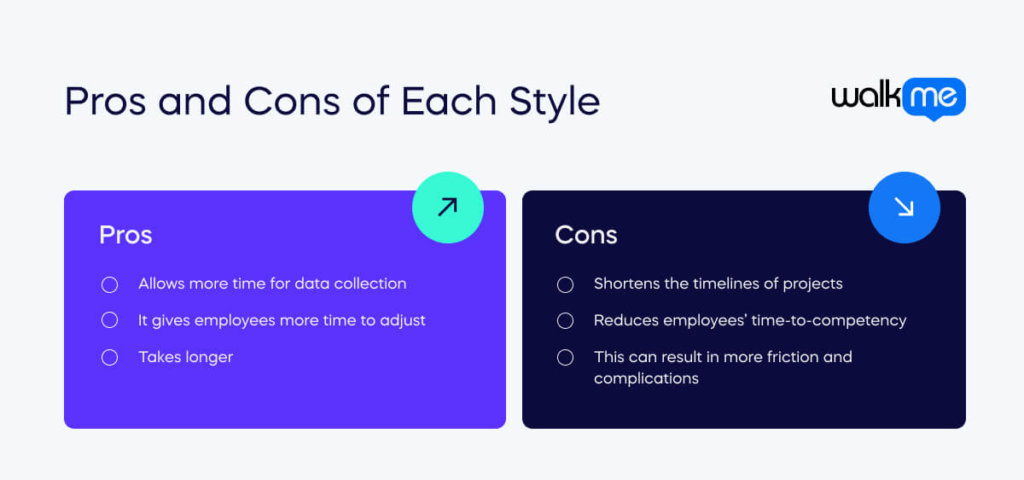IT and business managers often debate whether to implement major changes simultaneously (Big Bang) or incrementally.
According to supporters of the big bang approach, a significant organizational change can only be implemented by fully replacing the IT environment’s operating platform or network connection. There is no alternative in this situation but to proceed with a coordinated and immediate transition to ensure the job is done effectively.
Although anticipating change can help keep you ahead and achieve successful innovation, change management projects are often unpredictable and messy, as noted by Kotter (1996).
One potential solution to this issue is working with colleagues to gather a more complete understanding of the current framework. By harnessing the collective knowledge of a group, it can be easier to address technical problems and make adaptive changes.
But how does incremental change in business stack up against the “big bang” approach? And Is it better to implement new business projects all at once or in phases?
Both methods have advantages and disadvantages, but depending on the situation, one approach may be better.
This article will analyze and contrast the two styles of project implementation, highlighting the pros and cons of each.
The Difference Between Incremental Change vs. the “Big Bang” Approach
The main difference between incremental change and the “big bang” approach is their respective timelines. Incremental changes happen over a period of time, while the “big bang” approach requires a significant change to be made all at once.
Another difference is that incremental change requires a more detailed risk assessment and mitigation plan. With the big bang approach, risks are often unknown until the transition is complete.
Incremental change and all-at-once “big bang” changes can refer to a wide variety of business endeavors, including:
- Software rollouts, changes, or upgrades
- Digital transformation initiatives
- Organizational changes
- Business transformation projects
- Changes to business processes and workflows
- Organizational culture changes
In each of these scenarios, managers have a choice of how to move the project forward.
Incremental change gradually applies the change gradually, one step at a time.
If an organization adopts a new workplace protocol incrementally, for instance, then new rules and guidelines would be implemented slowly over a given period.
The “big bang” approach, on the other hand, applies those changes all at once. For instance, a software rollout that takes this approach would require the entire target user base to shift over to the new software overnight without leaving much time for testing or adjustment.
Each approach has its advantages and disadvantages, as we’ll see below.
Pros and Cons of Each Style

Each approach is viable in most business projects, and neither is superior to the other.
Instead, each approach has its own benefits and drawbacks, making each approach suitable for different circumstances.
The incremental change approach focuses more on risk management, gradually testing and implementing new technology or procedures. This allows teams to quickly identify and address potential problems before they become an issue.
Meanwhile, the “big bang” approach is more suitable for large-scale changes and projects that require a significant shift in organizational processes and operations.
An incremental or phased approach to change, for instance:
- Allows more time for data collection. Since incremental changes are deployed over time, change managers can track the program’s performance and learn which issues need to be addressed. They can then make adjustments early on before the program has been completed.
- It gives employees more time to adjust. Employees must not only unlearn old skills and relearn new ones but also often adapt to a new workplace environment. Many changes, after all, can affect team dynamics, the work atmosphere, the organization’s culture, and so forth. Changes such as these usually emotionally impact employees, so it is a good idea to ease that transition as much as possible.
- Takes longer. Incremental changes do have their benefits, but they also take longer. When speed is necessary, phased rollouts may not be viable for the business. In such situations, it is important to have an organization and a workforce that is adaptable, agile, and change-ready.
Rolling out new changes all at once, however:
- Shortens the timelines of projects. Rolling out a project all at once reduces the time it takes to complete a project. If an organization adopts a new software program all at once, for example, the old software is quickly abandoned, and there is no transition period.
- Reduces employees’ time-to-competency. One issue with incremental change is that employees can more easily retain old habits and workflows. And that attachment, in turn, can make it more difficult and time-consuming for employees to adopt new software.
- This can result in more friction and complications. All-at-once changes can be jarring if they are not handled correctly or if the change is too large. Such a rapid shift can create skill gaps and resistance from employees and even undermine the project’s goals.
Ultimately, the best approach for any business project will depend on that project’s specific goals and the organization’s capabilities.
As change managers know, employees are the heart of any change initiative.
Employees must be engaged and motivated to drive a change program forward. At the same time, they must also have the right skills for the job, and becoming productive requires training and practice.
The bigger the change, the more employees must learn and adapt, which is why a phased approach is often more suitable for large-scale projects.
How to Decide Which Approach Is Best

Below are a few factors to consider when choosing between an incremental approach to change and a rapid transition:
- The scale of the project. Larger projects, as mentioned, require more adjustments and have a larger impact on the workforce. For that reason, phased rollouts are often better for large-scale programs.
- The skills gap. Certain types of business projects, such as those involving product adoption, may require extensive employee training. If the skills gap is too large, then an incremental approach to deployment and training would probably be the best choice.
- The impact on the workplace and employees. Certain projects may require very little employee training while still greatly affecting workers. A merger or acquisition, for instance, could result in a changed organizational culture, which would affect the company’s existing beliefs, values, and behaviors. In other words, the workforce could easily be impacted emotionally, even if their job roles remain the same.
Having the right approach can make a significant difference in a project’s efficiency and outcomes, especially when that approach is accompanied by effective change management.
Choosing The Right Approach for Your Business Needs
Organizations planning to implement change need to weigh the pros and cons of both incremental and big-bang approaches to choose the best one for their needs.
It is important to understand the nature of the project, its impact on workers, and the skills gap that may exist. Having an experienced change management team in place to ensure that the transition goes as smoothly as possible is critical.
Ultimately, organizations must determine the most effective option for their particular needs and objectives. By carefully evaluating all available options, they can make an informed decision that will help them reach their goals.
For example, if the project is large and complex and significantly impacts the workforce, then an incremental approach may be the most suitable option. On the other hand, smaller projects that don’t require much employee training may benefit from a rapid transition.
Organizations that take their time to decide which approach is best for them will find it easier to meet their business objectives, drive success, and maintain employee engagement.
You’ve Chosen Your Approach. What’s Next?
Once you’ve chosen the best approach for your project, it is important to set up a plan that outlines all the tasks involved.
This plan should include training employees, communicating with stakeholders and other external parties, measuring success, and assessing progress. Having an effective change management strategy in place can help ensure that your transition is successful.
It can also be important to provide ongoing coaching and support for employees as they learn new skills and adapt to the changes. This type of guidance is particularly crucial if you’ve chosen an incremental approach to change.
No matter which approach you take, having a clear and concise plan in place and the right support and guidance will help ensure your transition is successful.
